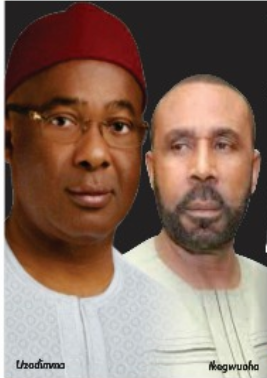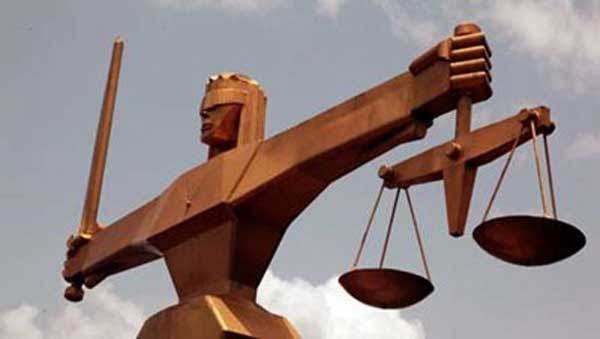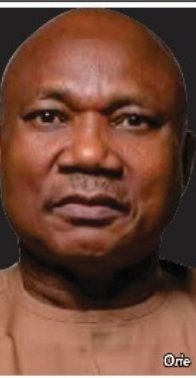– Uzodinma, Only Constructed 3 Federal Government Roads, Waiting For Refund-Steve Nwosu
The award conferred on the Governor of Imo State, Hope Uzodinma recently, as the Infrastructure Governor of the year, 2024, by Vanguard Newspaper, have elicited varied reactions from people within and outside Imo State, who described it as “absolute rubbish”.
One of such people is cerebral former Editor of Vanguard and This Day Newspapers, Steve Nwosu, who expressed disappointment at what he described as show of shame by Vanguard.
He berated the newspaper for conferring such award on Gov Uzodinma, who he said does not deserve it by any strength of judgment.
According to Nwosu, a thoroughbred journalist, who can separate the wheat from the chaff, “ Even the simplest of inquiry or a basic survey would show that the Imo governor is the least deserving of the honour bestowed on him by a national newspaper of Vanguard’s standing.
“One’s search everywhere to find the criteria or a list of infrastructure that earned UZODINMA the otherwise prestigious award yielded nothing.
“Even the government’s media team that ought to have stood in the gap, showcasing a blitzkrieg of bricks and mortar accomplishments in the last five years, failed in their duty.
“There was no such thing. Obviously there isn’t much to show.
“HOPE UZODINMA THE UNDERACHIEVER: With only about three years left to go, a keen observer of the Imo governor and government can safely conclude that Governor Hope Uzodinma has already been recorded by history as a poor, under-achieving governor – probably not much better than Rochas Okorocha who did two terms of eight years before him.
“In five years, Uzodinma had only three major roads to show. And these are federal roads which have been upgraded to double carriageways but obviously at less than the Federal standards.
“And of course, being a staunch member of the ruling APC, he is bound to receive prompt recompense from Abuja.
“Where have all Imo state money gone? Someday soon, Imo people will demand from Uzodinma where all the federal allocations to the state and local government councils gone?
“All the state and rural roads are in disrepair and this shall be apparent as the rains set in soon.
Schools, rural hospitals and most state infrastructure are in ruins across Imo State.
Local councils in Imo are completely abandoned as they are stripped of all federal allocations accruing to them monthly by the governor. Most of them are overgrown by bush with not a single project accomplished in five years.
Those started by Emeka Ihedioha, Uzodinma’s immediate predecessor, were all abandoned.
This is why it’s so hurtful that Vanguard Newspaper is rewarding Uzodinma’s mediocrity not to mention brigandage”.
Another investigative journalist who expressed reservation over the rationale that Vanguard Newspaper used in conferring the award on Gov Uzodinma, noted that the sum of #159 billion, the Uzodinma administration claims to have spent on Education is questionable, considering Infrastructural decay in over 90% of the schools in the state.
In a well investigated report by Crime fact Newspaper states, “crumbling walls, leaking roofs, and overcrowded classrooms have become the defining features of public education in Imo State, despite the government spending over ₦159 billion in education in the past five years. An investigation into the state of education infrastructure across the state reveals a stark disconnect between substantial budget allocations and the deteriorating conditions faced by thousands of students daily.
From Orlu to Okigwe and Owerri zones, public schools across Imo State’s 27 Local Government Areas tell a consistent story of neglect and disrepair.
Though these dilapidated infrastructure were not incurred by Governor Hope Uzodinma’s administration but the lack of substantial intervention in such vital sector in the last five years portrays the government in bad light, especially when the same government seems to have done comparatively well in road infrastructure within the period under review.
It raises serious questions about the effective utilization of funds that have been earmarked for educational development since 2021”.
Continuing, he said, “ Across Imo State’s three senatorial zones, public schools present a uniform picture of decay and neglect. The state boasts of 1,276 primary schools and 307 secondary schools, distributed across Orlu zone (492 primary, 107 secondary), Okigwe zone (283 primary, 66 secondary), and Owerri zone (500 primary, 134 secondary). Despite this extensive educational network, there is virtually no Local Government Area without its share of dilapidated school buildings.
A tour of schools reveals the extent of the crisis. At Mgbe Community Secondary School in Orlu, students attend classes in buildings with partially unsafe roofs and cracked walls. During rainy seasons, several classrooms become unusable, forcing students to crowd into the few functional spaces or miss school entirely.
The situation at Ejemekwuru/Akabor Secondary School in Oguta is equally dire. Here, broken windows, missing doors, and gaping roofs create an environment hardly conducive to learning. Teachers report having to relocate classes outdoors during extreme weather conditions due to safety concerns about the structural integrity of the buildings.
Once-prestigious institutions like Owerri Grammar School in Imerienwe now stand as shadows of their former glory. Facilities designed decades ago to accommodate hundreds of students have received minimal maintenance, resulting in limited and overcrowded classrooms, non-functional laboratories, and inadequate sanitation facilities.
Comprehensive Sec. Schl. Umudibia, Owerri West LGA
In Aboh Mbaise, Central School Egbelu Umuhu, Enyiogwugwu casts another deplorable image. Some classroom blocks are in ruin and abandoned after their roofs were damaged during storms years ago. Students now squeeze into the remaining limited spaces.
FILE: Leaking roofs and broken windows at Central School Egbelu Umuhu Enyiogugu, Aboh Mbaise
The story repeats itself at Township Primary School in Ubahu, Okigwe LGA, and Community Primary School Okigwe, where generations of students have passed through increasingly deteriorating facilities. Dilapidated buildings, broken furniture, exposed electrical wiring, and inadequate water supply are common features at these institutions.
Ojike Memorial Secondary School Orlu, seems to be one of such schools with the dilapidated infrastructure. Some of the old boys who visited the school recently expressed concern over the role of government in addressing the infrastructural decay even at a time that the Governor was conferred with the award of Infrastructure Governor of the year 2024.
Parents and community leaders express frustration at what they perceive as a disconnect between reported expenditures and visible improvements. “We hear about billions being spent on education, but when we look at our children’s schools, we wonder where this money goes,” said a parent-teacher association chairman from Owerri zone who craved anonymity.
However, Chief Justus Ohaegbu, a community leader called on the Imo state Government to urgently intervene in the pitiable state of the Ejemekwuru/Ababor Secondary School, stressing that if nothing is done to salvage the school, it would be difficult for students to access qualitative education from the school.
The PTA chairman of the school, Emeka Okereke, also bemoaned the plight of the school noting that the cost of rehabilitation work in the school, is not what the school or an individual can just handle. According to him, any intervention from Government will be deeply appreciated.
Fluctuating Allocations
The education sector in Imo State has witnessed significant fluctuations in budget allocations over the past five years, with a cumulative expenditure of over ₦159 billion that has failed to translate into visible improvements in school infrastructure.
In 2021, the state allocated ₦23 billion to education, marking a decrease from the 2020 appropriation. This reduction raised immediate concerns among education stakeholders about the government’s commitment to addressing the already deteriorating infrastructure.
The situation worsened in 2022 when the education budget was further slashed to ₦20 billion. Officials cited economic challenges and competing priorities as reasons for the reduction, but the decision prompted calls for increased investment in a sector considered crucial for the state’s development.
A slight recovery came in 2023 with an allocation of ₦25 billion. The government emphasized that this modest increase would focus on improving facilities and educational outcomes, though observers noted that the amount was insufficient to address the backlog of infrastructure needs that had accumulated over years of underfunding.
The year 2024 saw a significant boost in education funding. Initially proposed at ₦30 billion by Governor Hope Uzodinma as part of a strategy to revamp the sector, the final allocation was adjusted upward to ₦42.2 billion during budget implementation, reflecting what officials described as a renewed commitment to educational development.
For 2025, the state has allocated ₦49.46 billion to education, constituting 7.1% of the total state budget of ₦807 billion. This represents a 27.6% increase from the previous year, with stated focus areas including infrastructure development, teacher training, and educational resources.
Despite this upward trajectory in recent years, education advocates point out that even the current allocation falls significantly below the UNESCO-recommended benchmark of 15-20% of total budget for the education sector. This shortfall, they argue, continues to hamper efforts to address the systemic challenges facing schools across the state.
“While the recent increases are welcome, they come after decades of decline that allowed infrastructure to deteriorate to critical levels. The current funding, though improved, still falls short of what is needed for comprehensive rehabilitation.
Despite the widespread infrastructure challenges, findings reveal that for the immediate term, only about 10 projects seem to be part of Government’s response to basic education needs across the state. Of these, only four are ongoing projects, while the rest are newly initiated efforts.
The most significant allocations include the construction of 11 units of modern primary school buildings in Aboh Mbaise at ₦720 million (ongoing), similar projects in Ahiazu Mbaise (new) and Ezinihitte Mbaise (ongoing) at ₦720 million each, and a larger 14-unit modern primary school building in Ikeduru at ₦920 million (new). Ongoing renovation of 10 schools in 2025. A data from Imo State Citizens Budget
Additional projects include the construction of 11 units of modern primary school buildings in Mbaitoli at ₦720 million (new), land acquisition for relocating the Education Development Center (EDC) to a new site in New Owerri at ₦200 million (new), and the construction of three(3) smart schools across the state’s three senatorial zones at ₦500 million, with only the Owerri zone project currently ongoing.
Specialized education facilities have also received some attention, with ₦100 million allocated for constructing a chapel at the Deaf and Dumb School in Ofekata Orodo, Mbaitoli LGA, and ₦80 million for the renovation and rehabilitation of the School of the Deaf in Orodo, Mbaitoli. Additionally, ₦100 million has been earmarked for constructing new classroom blocks for model secondary schools in Owerri, Orlu, and Okigwe.
While these projects represent significant investments in specific locations, education experts and community leaders question whether they adequately address the scale of infrastructural decay across the state’s more than 1,500 schools.
The current projects, while welcome, represent intervention in less than 10% of the schools that need urgent attention. At this pace, it would take decades to address the backlog of infrastructure needs, during which time the currently functional facilities would have packed up.
Accountability Concerns
The apparent disconnect between substantial budget allocations and the persistent poor state of school infrastructure has raised serious questions about fund utilization and project implementation.
Education advocacy groups in the state have consistently emphasized the need for greater transparency and accountability in how education funds are managed. They point to the cumulative ₦159 billion spent over five years and question why this substantial investment has not translated into visible improvements across most schools.
“The issue goes beyond just allocation; it’s about effective utilization and monitoring,” said the director of a local civil society organization. “We need to see detailed breakdowns of how these funds are spent, regular progress reports on projects, and independent verification mechanisms to ensure that what’s reported on paper matches what exists on the ground.”
The state government, through its Ministry of Education, has maintained that efforts are being made to address the infrastructure challenges within available resources. Officials point to the increasing budget allocations in recent years as evidence of growing commitment to the sector, while acknowledging that the accumulated needs require time to address fully.
As Imo State continues to allocate substantial funds to its education sector — with over ₦159 billion spent in over five years and a record ₦49.46 billion budgeted for 2025 — the glaring disconnect between financial investment and infrastructure reality demands urgent attention. The paradox of increasing budgets alongside deteriorating facilities raises fundamental questions about governance, priorities, and the future of education in the state.
For the thousands of students attending classes in dilapidated buildings across Orlu, Okigwe, and Owerri zones, budget figures and policy pronouncements mean little without tangible improvements to their daily learning environments. The current pace of intervention, with only about 10 projects addressing basic education infrastructural needs in the fiscal year, falls drastically short of what is required to reclaim the sector.
The path forward requires not just increased funding but also fundamental reforms in planning, implementation, and accountability mechanisms. Without a comprehensive approach that addresses both the resource gap and governance challenges, the story of dilapidated schools in Imo State risks becoming a permanent feature rather than a solvable crisis”.









